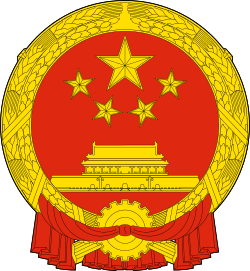Three-anti and Five-anti Campaigns
| History of the People's Republic of China (PRC) |
|---|
 |
| History of |
| Generations of leadership |
|
|
The Three-anti Campaign (1951) and Five-anti Campaign (1952) (Chinese: 三反五反; pinyin: sān fǎn wǔ fǎn) were reform movements originally issued by Mao Zedong a few years after the founding of the People's Republic of China in an effort to rid Chinese cities of corruption and enemies of the state. The result turned into a series of campaigns that consolidated Mao's power base by targeting political opponents and capitalists, especially wealthy capitalists.[1]
The Three-anti campaign
The Three-anti Campaign was launched in Manchuria at the end of 1951. It was aimed at members within the Communist Party of China, former Kuomintang members and bureaucratic officials who were not party members.[2]
The 3 antis imposed were:
- corruption (反对贪污)
- waste (反对浪费)
- bureaucracy (反对官僚主义)[3]
The Five-anti campaign
The Five-anti campaign was launched in January 1952. It was designed to target the capitalist class. The Communist party set a very vague guideline of who could be charged, and it became an all out war against the bourgeoisie in China.[2] Deng Xiaoping warned the people "not to be corrupted by capitalist thinking".[3]
The 5 antis imposed were:
- bribery (反对行贿)[2]
- theft of state property (反对盗骗国家财产)
- tax evasion (反对偷税漏税)
- cheating on government contracts (反对偷工减料)
- stealing state economic information (反对盗窃国家经济情报).
An estimated 20,000 cadres and 6,000 trained workers began spying on the business affairs of fellow citizens. The media encouraged compliance with the government policies. Up to 15,000 trained propagandists were working in Shanghai by late 1951.[2] By February 1952, parades of anti-Capitalist activists went door-to-door to visit business leaders. It created immense psychological pressure. Shanghai wards were set up to receive criticism letters from any employees. As many as 18,000 letters came in the first week of February 1952, and 210,000 came in by the end of the first month. Cadres of party members would join in on the attack. Some big companies would voluntarily make 1,000 confessions a day to try to protect themselves from the government.[2] A prime example was the Dahua copper company owner who originally over-confessed by claiming to have illegally obtained 50 million yuan. His employees continued to criticize the owner for greater crime until he reconfessed to having obtained 2 billion yuan.[2]
Aftermath
The victims of the antis campaigns were mostly terrified and humiliated, some were killed, and others were sent to labor camps around China. Mao evaluated the situation, saying that "We must probably execute 10,000 to several tens of thousands of embezzlers nationwide before we can solve the problem."[4] The Three-Antis Campaign came with harsher punishments, some involving torture, and all found guilty of their confessed or unconfessed crimes were made to pay fines to the government. There were hundreds of thousands of suicides (though it is debatable whether many of these were voluntary) that were a direct result of these campaigns.[5]
Eventually the Communist Party revealed that it would no longer protect private business, and that Chinese capitalists would receive treatment no better than foreign.[2] The Korean War initially provided opportunities in Northern China, giving rise to a new class of capitalists, many of whom would be prosecuted under the Marxist policies of the Communist Party. Many of these people eventually borrowed money from the government to pay off government fines, creating a complex financial pattern.[2] A series of anti campaigns were launched by the Chinese government in the following years.[6]
See also
References
- ↑ Dillon, Michael. [1998] (1998). China: A Historical and Cultural Dictionary. Routledge publishing. ISBN 0-7007-0439-6
- 1 2 3 4 5 6 7 8 Spence, Jonathan D. [1991] (1991). The Search for Modern China. WW Norton & Company publishing. ISBN 0-393-30780-8
- 1 2 Lawrence, Alan. [2003] (2003). China since 1919: Revolution and Reform: a Sourcebook. Routledge. ISBN 0-415-25142-7
- ↑ Changyu, Li. "Mao's "Killing Quotas."] Human Rights in China (HRIC). 26 September 2005, at Shandong University" (PDF).
- ↑ Short, Philip (2001). Mao: A Life. Owl Books. p. 437. ISBN 0-8050-6638-1.
- ↑ Fisac, Taciana and Fernández-Stembridge, Leila. [2003] (2003). China Today: Economic Reforms, Social Cohesion and Collective Identities. Routledge publishing. ISBN 0-415-31267-1